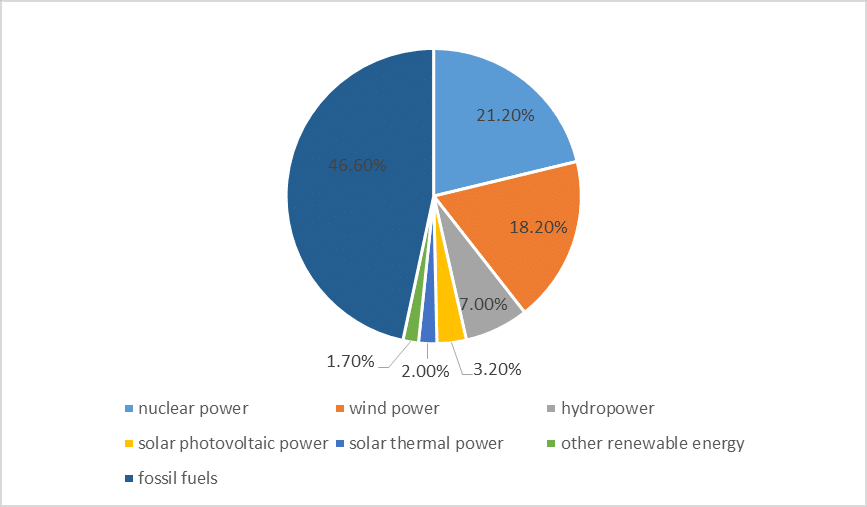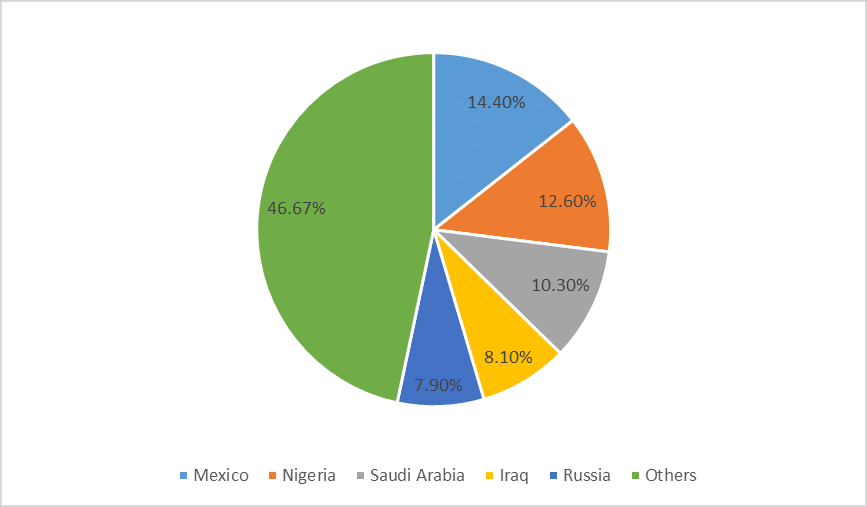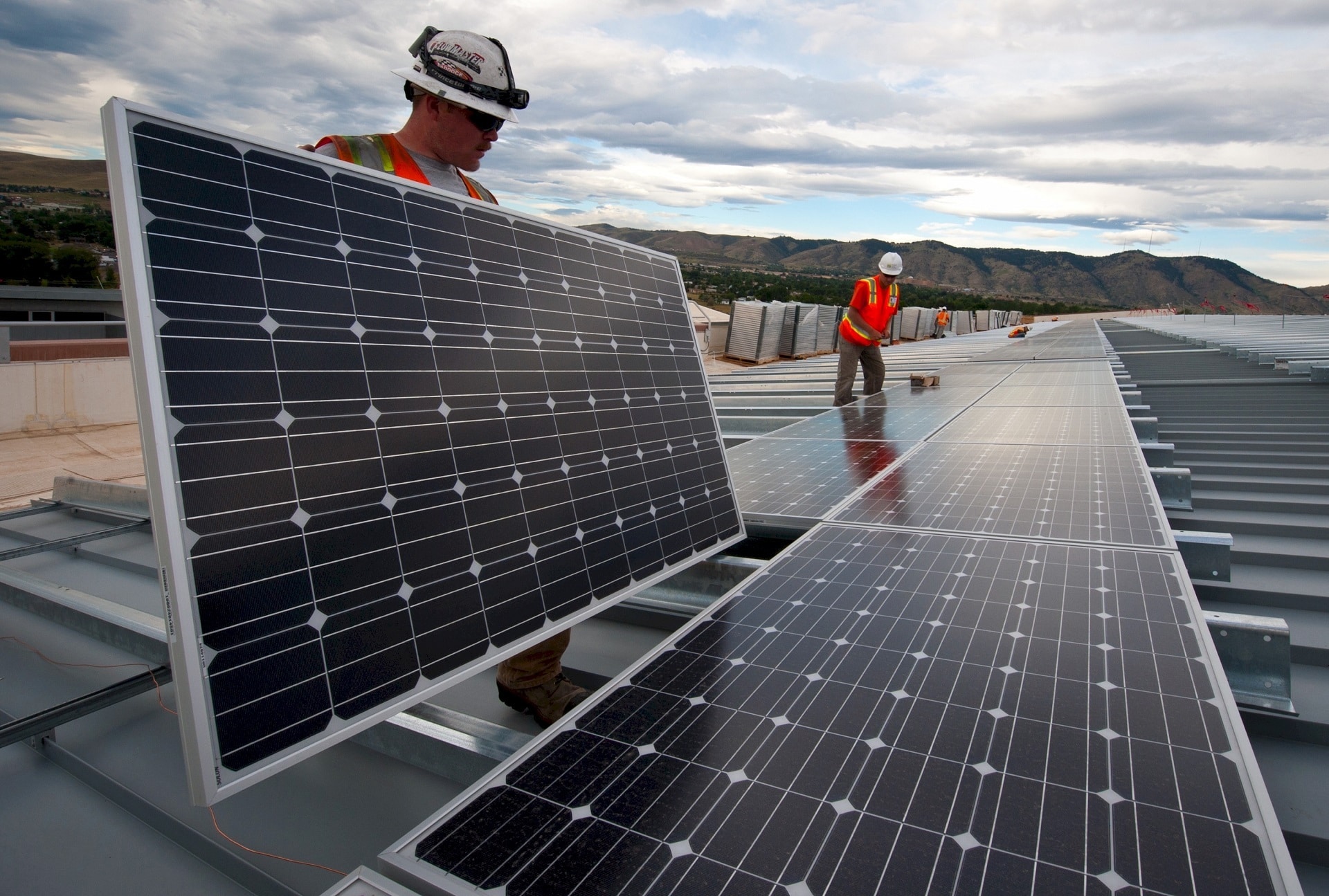Spain is located on the new Euroasian land bridge in the Silk Road Economic Belt. Although Spain has not yet officially assigned to the BRI cooperation, it has jointly released with China the Joint Statement on Strengthening Comprehensive Strategic Partnership during the visit of China’s President Xi in Nov 2018, in which it expressed its willingness to synergize the BRI with the European Infrastructure Guide Plan and the Euroasia Connectivity, while looking forward to regular dialogues and experience-sharing on promoting the usage of renewable energy and improving energy efficiency as the cornerstones to future sustainable development.[1]
The resources and potential of renewable energy in Spain
According to the International Renewable Energy Agency (IRENA), by the end of 2017, Spain’s installed renewable energy capacity is 47.98 GW. Among them, the capacity of wind power and hydropower are 22.99 GW and 20.03 GW, accounting for 47.9% and 41.7% respectively and in total amounting to about 90% of Spain’s installed renewable energy capacity. In comparison, the installed capacity of solar power and biomass power is 7 GW and 1 GW respectively, which are relatively low. In recent years, the development of Spain’s renewable energy has been slow – between 2014 and 2017, the annual growth rate of Spain’s installed renewable energy was only 0.1%.[2]
| 2014 | 2015 | 2016 | 2017 | Average growth rate between 2014-17 | |
| Total installed renewable energy capacity | 47847 | 47890 | 48021 | 47989 | 0.10% |
| Wind power | 22975 | 22943 | 23003 | 22988 | 0.02% |
| Hydropower | 19223 | 20053 | 20056 | 20034 | 1.41% |
| Solar power | 7087 | 7156 | 7273 | 7278 | 0.89% |
| Biomass power | 1017 | 1018 | 1018 | 1018 | 0.03% |
Table 1: Spain’s installed renewable energy capacity by category, 2014-17 (in MW)
Source:IRENA, RENEWABLE CAPACITY STATISTICS 2018, March 2018,
https://www.irena.org/publications/2018/Mar/Renewable-Capacity-Statistics-2018 .
Although the growth of Spain’s renewable energy installation has been slow in recent years, it is still one of the world’s largest producers of renewable energy. In 2017, Spain generated 263 tWh electricity, in which renewable energy accounted for about 32%. In more details, wind power accounted for 18.2%, hydropower 7%, solar photovoltaic 3.2%, solar thermal power 2% and others 1.7%.[3]

Figure 1: Energy structure of Spain’s electricity production, 2017 (in %)
Source: RED ELÉCTRICA DE ESPAÑA
Spain possesses abundant wind power resources. Its onshore wind resources mainly concentrate in the north-western region of Galicia and the south region of Andalusia, and sea wind power resources concentrate in the northeast and southeast coastal areas. These areas have an annual average wind speed of more than 6.5 meters per second, which indicate a great potential of wind power development. According to research data of University de Zaragoza, onshore wind potential in Spain can reach 1100 tWh per year.
In addition, Spain has the best sunlight condition in Europe, with the average annual solar radiation intensity in most areas ranging from 1,600 KW/m2 to 1,950 KW/m2. The country’s solar energy resources mainly come from the Andalusia region in the south and the Asturias, Cantabria and Pesvasco in the north. In addition, the Spanish Peninsula hydropower potential is considered up to 138 tWh per year.[4]
The development plan and incentive policies on renewable energy in Spain
In 2016, the total consumption of standard oil in Spain totalled 135 million tons, making the country the 5th largest energy consumer in the European Union. However, its crude oil and natural gas production were very small, and it relied on foreign imports for oil and gas fuel. Spain imported about 1.3 million barrels of crude oil per day, mainly from Mexico, Nigeria, Saudi Arabia, Iraq and Russia.[5]

Figure 2: Spain’s import of crude oil in 2016 (in %)
Source: Ministerio de Energía, Turismo y Agenda Digital
In 2017, Spain consumed 32 billion m3 natural gas, which are mostly imported due to nearly no domestic natural gas production.[6] In 2017, Spain imported about 11.8 billion m3 natural gas from Algeria through the Algerian-European Gas pipeline (Maghreb-Europe Gas pipeline)[7] and the Medgaz pipeline[8], which accounted for about 38% of its total natural gas imports of that year. In addition to pipeline gas, Spain imported 16.6 billion m3 liquefied natural gas (LNG) from countries such as Nigeria, Peru, Qatar, Algeria, and Norway in 2017.[9]
To optimize its energy structure, reduce the reliance on imported fossil energy and accelerate the development of low-carbon economy, the Spanish government established the National Renewable Energy Action Plan 2011-2020, which set the goal of increasing the renewable electricity production to 39% in 2020.[10] In addition, the Spanish government also formulated a series of concrete policies on developing renewable energy, such as feed-in tariffs. Though these policies have accelerated the development of wind power and other renewable energy in Spain, their stimulation are more than necessary in the way that the available government subsidy could hardly catch up with the development of renewable energy. Particularly, after the European Debt Crisis, the shortage of public funds faced by the Spanish government severely restricted its ability of providing government subsidy, which was in fact the main reason why the growth of renewable energy installation has been slowed down in recent years.
With the advancement of technology and cost reduction of electricity generation using renewable energy, the Spanish government implemented energy reforms to encourage investors to participate in domestic renewable energy projects by way of public bidding, making use of the role of the market rather than the previous subsidy. The new round of public bidding started in May 2017 with a targeted capacity of 3000MW and no additional charges on consumers.[11] In Nov 2018, Spain’s Ministra para la Transición Ecológica submitted a draft proposal, which suggested an annual growth of 3GW installed renewable energy capacity in 2020-2030 and full utilization of renewable energy in domestic electricity production in 2050.[12]
China-Spain cooperation on renewable energy
Spain plays a leading role in research and development of renewable energy technologies, equipment manufacturing and project development. The current China-Spain cooperation on renewable energy is mainly on import of wind power and export of solar photovoltaic.
China-Spain cooperation on wind power
In Sept 2014, Hebei Jiangong Group and Spain’s Gamesa Wind (Tianjin) Limited signed a supply agreement under which Gamesa Wind supplies fans and related auxiliary equipment for Hebei Fining Wind Power Plant project (phase 2) with installed capacity of 150MW.[13]
China-Spain cooperation on solar photovoltaic
In recent years, Chinese solar photovoltaic companies have made great breakthroughs in the Spanish market. For example, in Jun 2018, by winning the tender for the 182.5MW large photovoltaic power plant project in Spain, Jinko Power became the first Chinese component supplier for solar photovoltaic bidding projects after Spain’s energy reform. The project is situated in Alcaláde Guadaira in Seville, Spain, with installed capacity of 182.5MW. It is estimated to be completed at the end of 2019 at earliest and be able to generate about 356 million kWh electricity annually during operation. Jinko Electric also signed a 20-year purchase and sale agreement of electricity with Spain’s Comisión Nacionaldelos Mercadosyla Competencia (CNMC/National Markets and Competition Commission).[14]
In June 2018, Huawei signed a supply agreement with Spain’s Grupotec and became the sole inverter supplier for the latter’s 168MW SUN2000-100KTL1500V intelligent series inverter and turnkey intelligent photovoltaic solution. This project would further accelerate the promotion and application of intelligent photovoltaic in Spain.[15]
In Dec 2018, Sungrow and Spain’s component manufacturer and EPC integrator Solaria signed a supply agreement for a 400MW 1500V turnkey solution. The supply has already begun in 2019. With low cost and grid-friendly connection, this solution is very suitable for Spain’s hot climate, meeting the special needs of the local grid connection. After operation, the annual electricity output could serve 150,000 inhabitants as a strong electricity safeguard for local residents and enterprises.[16]
Besides, in March 2019, Risen Energy signed a development cooperation agreement with Spain’s photovoltaic giant OPDEnergy on a 261MW project. According to the agreement, Risen Energy will supply efficient components for the power plant project contracted by OPDEnergy. The average efficiency of Risen Energy’s double-sided AlOx passivation PERC cell exceeds 22.2%, and the highest efficiency of the production line reaches 22.51%. The strong innovation and R&D ability is one of the most important reasons why OPDEnergy has chosen Risen Energy as the cooperative partner.[17]
Apart from the export of photovoltaic components, Chinese enterprises also participate in Spain’s photovoltaic market through mergers and acquisitions. In Jan 2018, AVIC International, a subsidiary of AVIC, purchased the construction project of a 90-hectare 50MW solar photovoltaic power plant in the Paracuellos de Jiloca, Saragsa, with 41 million EUR from the local real estate investment company Alizarsun SL. This purchase is another successful purchase by AVIC International in European renewable energy market after its purchase of a 12MW ground photovoltaic power plant in the UK in 2014. [18]
Push and influence factors of China-Spain cooperation on renewable energy
The Spanish government has a relatively aggressive renewable energy development plan, providing future market opportunities. According to Spain’s national energy and climate plan, renewable energy would generate at least 74% of electricity for the country by 2030 and 100% by 2050. Spain could become the world’s second or third largest photovoltaic market if it meets the goal of adding 3 GW solar capacity per year by 2030. As estimated by HIS markit, Spain could become the fastest growing photovoltaic market in 2019, returning to the “GW photovoltaic market” for the first time since 2008.[19]
Secondly, the Spanish government has matched its plans with corresponding renewable energy incentive policies. For example, the Spanish Central Government guaranteed the feed-in fees of the Jinko Power’s 182.5MW large photovoltaic power plant project, while the local government offered certain preferential tax treatments. However, it should also be noted that the Spanish government no longer provides high subsidies for renewable energy projects due to financial pressures. The reduction and even complete elimination of subsidies for renewable energy would directly affect the investment income in relevant renewable energy projects.[20]
Thirdly, Chinese enterprises have stronger comprehensive strengths. The development of Europe’s renewable energy starts relatively early and the market competition is relatively fierce, enterprises must have a competitive comprehensive strength to participate in such a large renewable energy market. In Jinko Power’s 182.5MW large photovoltaic power plant project, 30 globally well-known power development companies such as Enel (Italy’s national electric power company), GasNatural (a Spanish gas giant) and XElio (a Spainish photovoltaic project developer) also participated in the bidding, but owing to Jinko Power’s comprehensive advantages in project development, financing, investment, construction, operation, maintenance and cost control in overseas photovoltaic power plant projects, Jinko Power was chosen as the contractor. [21]
Last but not least, Spain offers a friendly investment environment. Spain has left behind most of the consequences of the European Debt Crisis and resumed economic development. It also has sound laws and regulations on foreign investment with high policy transparency. Law firms and accounting firms play a positive role as investment intermediaries [22], which formed good investment environment for Chinese enterprises to participate in the Spanish renewable energy market.
References
[1] Yidaiyilu.com, “China-Spain Joint Statement on Strengthening Comprehensive Strategic Partnership” [EB/OL], https://www.yidaiyilu.gov.cn/zchj/sbwj/72991.htm,2018-22-29.
[2] IRENA, RENEWABLE CAPACITY STATISTICS 2018, March 2018.
https://www.irena.org/publications/2018/Mar/Renewable-Capacity-Statistics-2018
[3] RED ELÉCTRICA DE ESPAÑA, Renewable energy in the Spanish electricity system2017.
https://www.ree.es/sites/default/files/11_PUBLICACIONES/Documentos/Renewable-2017.pdf
[4] Global Energy Network Institute, “Can Spain Reach 100% Renewable Energy by 2020?” [R/OL], http://www.geni.org/globalenergy/research/renewable-energy-potential-of-spain/100_percent_REN_Spain_Nigel.pdf,2011-9.
[6] BP, BP Statistical Review of World Energy 2018, June 2018.
https://www.bp.com/content/dam/bp-country/zh_cn/Publications/2018SRbook.pdf
[7] The pipeline starts from the Hassi R ‘mel Gas Field in Algeria, goes west through Morocco, crosses the Mediterranean Sea at the Tangier Port to the north, disembarks at the Tarifa Port in Spain, and ends at Cordoba in Andalusia. It is connected with Spanish and Portuguese gas pipeline network. The construction began in October 1994, and was completed and put into operation in December 1996.
[8] The pipeline started from the Hassi R ‘mel Gas Field in Algeria, crossed the Mediterranean Sea at the Benissaf Port, disembarks from Almeria, Spain, and is connected with the existing natural gas pipeline network in Spain. The total length of the pipeline is 757 km, including a 547km onshore pipeline and a 210km submarine pipeline, with a designed gas capacity of 8 billion m3 per year. The construction began in March 2008, and was completed and put into production in March 2011.
[9] BP, BP Statistical Review of World Energy 2018, June 2018.
https://www.bp.com/content/dam/bp-country/zh_cn/Publications/2018SRbook.pdf
[10] IEA, “National Renewable Energy Action Plan 2011-2020”[EB/OL], http://www.iea.org/policiesandmeasures/pams/spain/name-24876-en.php?s=dHlwZT1yZSZzdGF0dXM9T2s,&return=PG5hdiBpZD0iYnJlYWRjcnVtYiI-PGEgaHJlZj0iLyI-SG9tZTwvYT4gJnJhcXVvOyA8YSBocmVmPSIvcG9saWNpZXNhbmRtZWFzdXJlcy8iPlBvbGljaWVzIGFuZCBNZWFzdXJlczwvYT4gJnJhcXVvOyA8YSBocmVmPSIvcG9saWNpZXNhbmRtZWFzdXJlcy9yZW5ld2FibGVlbmVyZ3kvIj5SZW5ld2FibGUgRW5lcmd5PC9hPjwvbmF2Pg,2010.
[11] Oficina del Consejero Economico-Comercial de la Embajada de la Republica Popular China en el Reino de Espana, “Spanish government is preparing to launch a new round of renewable energy tender”[EB/OL], http://es.mofcom.gov.cn/article/jmxw/201705/20170502583380.shtml,2017-5-29.
[12] Chuneng BJX.com, “Spain revises its renewable energy bill to achieve 100% renewable electricity by 2050” [EB/OL], http://chuneng.bjx.com.cn/news/20181119/942511.shtml,2018-11-19.
[13] Wind Power BJX.com, “Spain signs a 3.2 billion EUR deal with China: wind and nuclear power (electricity)” [EB/OL], http://news.bjx.com.cn/html/20140926/550325.shtml,2014-9-26.
[14] CN Stock,”182.5MW! Jinko Power won the bidding for Spain’s first photovoltaic power station after the energy reform” [EB/OL], http://guangfu.bjx.com.cn/news/20180622/907676.shtml, 2018-6-22.
[15] Solar Photovoltaic BJX.com, “Huawei won the 168MW contract in Spain” [EB/OL], http://guangfu.bjx.com.cn/news/20180615/906407.shtml,2018-6-15.
[16] Solar Photovoltaic BJX.com, “Sungrow won an order of 400MW 1500V in Spain – continuing to lead the global market” [EB/OL], http://guangfu.bjx.com.cn/news/20181224/951360.shtml,2018-12-24.
[17] Risen Energy, “Another successful layout in the Spanish market: Risen Energy won a 261MW large project in Spain” [EB/OL], http://guangfu.bjx.com.cn/news/20190306/967132.shtml, 2019-3-6.
[18] Toutiao News, “AVIC International spent 41 million ERO purchasing a Spanish photovoltaic power plant project” [EB/OL], http://news.7654.com/a/1984807656373955481?TAG=8_47
[19] Sxcoal, “Spain will be the fastest growing market for photovoltaic installations in 2019”[EB/OL], http://www.sxcoal.com/news/4588494/info,2019-3-12.
[20] Cao Hui, The de-subsidization of the EU renewable energy industry and its influence on China [J], China Energy, 2016, 38(11):25-28+24.
[21] CN Stock, “182.5MW! Jinko Power won the bidding for Spain’s first photovoltaic power station after the energy reform” [EB/OL], http://guangfu.bjx.com.cn/news/20180622/907676.shtml, 2018-6-22.
[22] Chinese Academy of International Trade and Economic Cooperation, Ministry of Commerce of the People’s Republic of China – Department of Outward Investment and Economic Cooperation, Oficina del Consejero Economico-Comercial de la Embajada de la Republica Popular China en el Reino de Espana:Outboung Investment Guide by Country (Region) – Spain (2018), 2018-9, http://www.mofcom.gov.cn/dl/gbdqzn/upload/xibanya.pdf





Comments are closed.